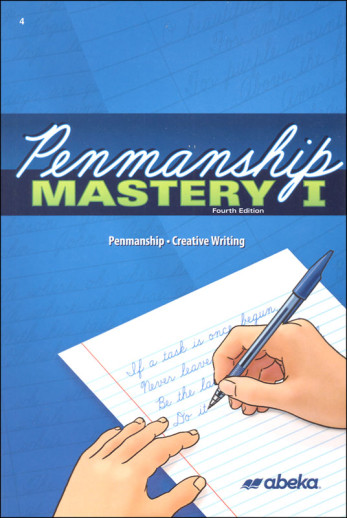Whatsoever thy hand findeth to do, do it with thy might. Ecclesiastes 9:10 Abeka's approach to handwriting/penmanship is unique in a few major ways. First, is their commitment to cursive handwriting from the earliest levels. A preference for cursive handwriting (an extension of the natural tendency of children to draw in loops) marks their K4 and K5 materials. Although they do offer a manuscript option in terms of books and curriculum plans, still it is cursive that is incorporated into their overall lesson plans. And, cursive is the only handwriting option after 1st grade.
Second, is their coverage of composition practice in the penmanship materials. Combining penmanship instruction/practice with composition practice might seem logical, but it is rarely found in curriculum. Abeka's handwriting program is an exception. Although the earliest years of handwriting instruction/practice are correlated with letter/sound instruction, that begins to change toward the end of the 1st grade materials when paragraph composition is introduced. Paragraph writing and writing prompts are woven throughout the Grade 2 materials. Starting with Grade 3, composition and creative writing become a central focus, although the materials never lose sight of the need for penmanship practice.
Throughout the program, good writing position is emphasized. Coupled with this emphasis is a handy handwriting house icon that has colorful details for youngest students and morphs into an outline form for more experienced writers (i.e. 1st and 2nd grades). The writing house is a set of lines. The upper line is the ceiling of the upstairs; dotted line is the ceiling of downstairs; the pink line is the floor of the downstairs; while the basement line is the floor of the basement. These house locations are referenced in letter formation instruction and used in formal and informal evaluation of handwriting specimens.
For instance, here is one example from the K4 level: "Little s lives in the downstairs. He looks like a little worm. . . . . . Capital S lives in the upstairs and downstairs. He looks like a big snake."
Handwriting/penmanship workbooks (instruction) and practice tablets (additional practice) are included in the Language Arts Student kits. The Curriculum Lesson Plans included with the Parent Kit provide handwriting instruction using the cursive materials integrated with other language arts subjects. All kit components can be purchased as individual products and the handwriting program can be done separately from either the Phonics or Language Arts instruction. Separate manuscript lesson plans are available. Although the lesson plans are helpful (and necessary if you want the correlation with other language arts subjects), you could probably use the handwriting books by themselves as the workbooks each include proper hand and body posture as well as letter formation guides.
Many of the student handwriting components for the early grades come in either a bound or an unbound version. This means you will want to think through how you plan to use the book. For lots of reasons, it is best for young students to work on a single page rather than in a workbook. With the bound version, you can remove one perforated page at a time. The unbound version eliminates that job, but means you need some method of keeping the pages organized (I would use a 1/2" file jacket).
Overall, Abeka® Handwriting is an excellent program with plenty of practice, an emphasis on proper position, and the incorporation of composition. Ongoing evaluation is another emphasis with tests surfacing at the first-grade level. Colorful materials engage the youngest students and edifying copywork choices are another plus. ~ Janice


